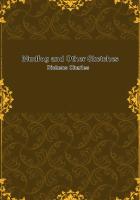Where this brilliant, beautiful orchid and its lovely white sister grow together in the bog - which cannot be through a very wide range, since one is common northward, where the other is rare, and vice versa - the yellow fringed orchis will be found blooming a few days later.In general structure the plants closely resemble each other.Their similar method of enforcing payment for a sip of nectar concealed in a tube so narrow and deep none but a sphinx moth or butterfly may drain it all (though large bumblebees occasionally get some too, from brimming nectaries) has been described (q.v.), to which the interested reader is referred.Both these orchids have their sticky discs projecting unusually far, as if raised on a pedicel - an arrangement which indicates that they "are to be stuck to the face or head of some nectar-sucking insect of appropriate size that visits the flowers," wrote Dr.Asa Gray over forty years ago.Various species of hawk moths, common in different parts of our area, of course have tongues of various lengths, and naturally every visitor does not receive his load of pollen on the same identical spot.At dusk, when sphinx moths begin their rounds, it will be noticed that the white and yellow flowers remain conspicuous long after blossoms of other colors have melted into the general darkness.Such flowers as cater to these moths, if they have fragrance, emit it then most strongly, as an additional attraction.Again, it will be noticed that few such flowers provide a strong projecting petal-platform for visitors to alight on; that would be superfluous, since sphinx moths suck while hovering over a tube, with their wings in exceedingly rapid motion, just like a hummingbird, for which the larger species are so often mistaken at twilight.This deep-hued orchid apparently attracts as many butterflies as sphinx moths, which show a predilection for the white species.
>From Ontario and the Mississippi eastward, and southward to the Gulf, the TUBERCLED or SMALL PALE GREEN ORCHIS (H.flava) lifts a spire of inconspicuous greenish-yellow flowers, more attractive to the eye of the structural botanist than to the aesthete.It blooms in moist places, as most orchids do, since water with which to manufacture nectar enough to fill their deep spurs is a prime necessity.Orchids have arrived at that pinnacle of achievement that it is impossible for them to fertilize themselves.More than that, some are absolutely sterile to their own pollen when it is applied to their stigmas artificially with insect aid, however, a single plant has produced over 1,000,700seeds.No wonder, then, that, as a family, they have adopted the most marvelous blandishments and mechanism in the whole floral kingdom to secure the visits of that special insect to which each is adapted, and, having secured him, to compel him unwittingly to do their bidding.In the steaming tropical jungles, where vegetation is luxuriant to the point of suffocation, and where insect life swarms in mvriads undreamed of here, we can see the best of reasons for orchids mounting into trees and living on air to escape strangulation on the ground, and for donning larger and more gorgeous apparel to attract attention in the fierce competition for insect trade waged about them.Here, where the struggle for survival is incomparably easier, we have terrestrial orchids, small, and quietly clad, for the most part.
Having the gorgeous, exotic air plants of the hothouse in mind, this little tubercled orchis seems a very poor relation indeed.
In June and July, about a week before the ragged orchis comes out, we may look for this small, fringeless sister.Its clasping leaves, which decrease in size as they ascend the stem (not to shut off the light and rain from the lower ones), are parallel-veined, elliptic, or, the higher ones, lance-shaped.Aprominent tubercle, or palate, growing upward from the lip, almost conceals the entrance to the nectary.and makes a side approach necessary.Why? Usually an insect has free, straight access down the center of a flower's throat, but here he cannot have it.A slender tongue must be directed obliquely from above into the spur, and it will enter the discal groove as a thread enters the eye of a needle.By this arrangement the tongue must certainly come in contact with one of the sticky discs to which an elongated pollen gland is attached.The cement on the disc hardening even while the visitor sucks, the pollen gland is therefore drawn out, because firmly attached to his tongue.At first the pollen mass stands erect on the proboscis; but in the fraction of a moment which it takes a butterfly to flit to another blossom, it has bent forward automatically into the exact position required for it to come in contact with the sticky stigma of the next tubercled orchis entered, where it will be broken off.Now we understand the use of the palate.Butterfly collectors often take specimens with remnants of these pollen stumps stuck to their tongues.In his classical work "On the Fertilization of Orchids by Insects," Darwin tells of finding a mottled rustic butterfly whose proboscis was decorated with eleven pairs of pollen masses, taken from as many blossoms of the pyramidal orchis.Have these flowers no mercy on their long-suffering friends? A bee with some orchid pollen-stumps attached to its head was once sent to Mr.Frank Cheshire, the English expert who had just discovered some strange bee diseases.
He was requested to name the malady that had caused so abnormal an outgrowth on the bee's forehead!















